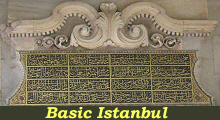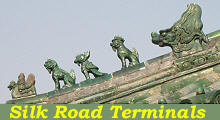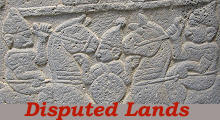

What's New!
Detailed Sitemap
All images © by Roberto Piperno, owner of the domain. Write to romapip@quipo.it. Text edited by Rosamie Moore.
Page added in October 2010.
|

 - page three: inside
the monasteries - page three: inside
the monasteries
Monastery of Megalo Meteoron: (left) apse of the "katholicon", the major church of the monastery; (right) apse of another church
The monastery of Megalo Metereon was founded by Athanasius Koinovitis, a monk from Mount Athos (St. Athanasius Meteorites for the Greek Orthodox Church), in 1356; it was enlarged and embellished towards the end of the century by John Uros, a member of the Serbian dynasty ruling Thessaly, who became a monk and later on the leader of the community; the apse of the katholikon is part of the original building, while the rest of it was modified in the
XVIth century.
Katholicon of Varlaam monastery
Varlaam monastery was founded in the XVIth century on the site of the lodgings of Varlaam, a hermit; the katholicon (dedicated to All Saints) was completed in 1544; it incorporates a previous chapel; it has a second dome above the narthex. The image used as background for this page is based on paintings inside the katholicon.
Monastery of Agios Stefanos - Dormition of the Theotokos (the Virgin Mary)
The interior of most of the churches was decorated with frescoes, some of which have required a lengthy restoration because of the damage
caused by abandonment, WWII and the Greek Civil War which followed; the subjects are those traditional in the Greek Orthodox Church.
Monastery of Agios Nikolaos Anapafsas: scenes of Jesus' life
The frescoes inside the only church of Agios Nikolaos Anapafsas were painted by Theophanes Strelitzas, a monk from Candia (today Iraklion), the main town of Crete. Owing to his exposure to Italian art (the island was a Venetian possession) his works soften the rigidity of Byzantine paintings.
Monastery of Agios Nikolaos Anapafsas: scenes of the life of St. Ephrem the Syrian
The ingenuity and skill of Theophanes Strelitzas are particularly evident in the small scenes which surround the main subject, which is treated in a traditional way.
Monastery of Agios Nikolaos Anapafsas: Last Judgement
The depiction of the Last Judgement is an integral part of the decoration of an Orthodox church; it is placed so that the faithful see it on their way out of the building, in order to remind them that they will be judged for their actions; the structure of the painting follows a rigid pattern;
the artist can show his skill and his ingenuity only in portraying the wicked.
(left) Vrizon (hoist) tower at Varlam; (right) equipment (hoist and net) at Megalo Meteoron
Monasteries were accessed by rope ladders, while the old and the sick were hauled up in a net raised by a hoist;
as a matter of fact this equipment was mainly used for commodities.
Ways of accessing the monastery of Agia Triada; (inset) people waiting on the steps for the access door to be opened
Although some modern visitors would enjoy being raised in a net, as a sort of extreme sport, today the monasteries are accessed via steps cut into the rock and commodities arrive via small cable cabins.
Relaxing and not so relaxing images: (left) garden at Agios Stefanos; (right) ossuary at Megalo Meteoron
Move to page one - introduction or page two: views of the monasteries.
SEE THESE OTHER EXHIBITIONS (for a full list see my detailed index).
  
|